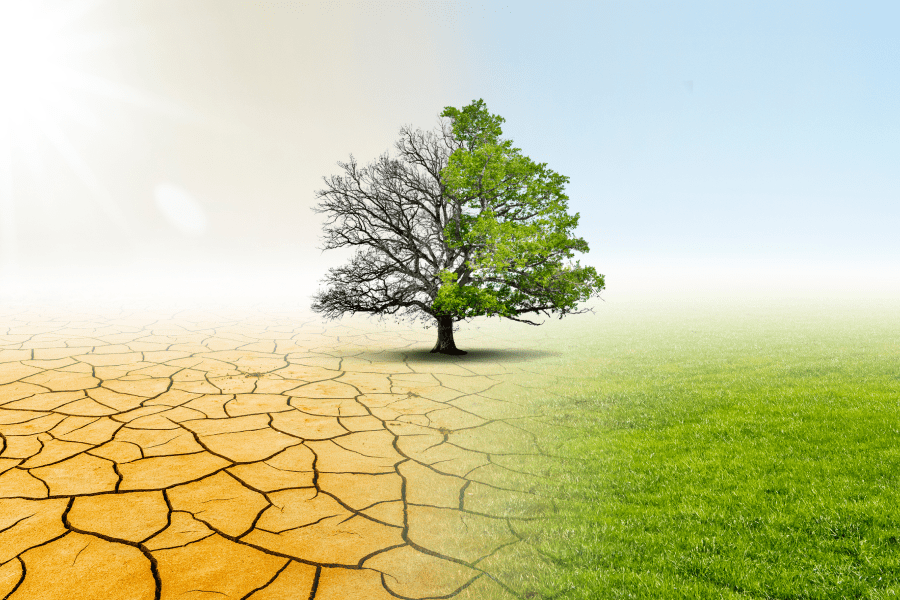Megadrought and Vineyard Irrigation in California: What We’ve Learned

This isn’t the first long drought that California winegrowers have faced in the last century. The 1920s and 1930s were riddled with dry spells, and significant droughts affected agricultural production about once a decade between the 1970s and 1990s.
So, what’s changed? Why is this current drought different from all other droughts?
Making Mega History
Well, for starters, this is a megadrought. Megadroughts are defined as occasional drought events of unusual severity lasting at least 20 years. Sound familiar?
According to paleoclimatic data, the last two decades have been the driest period on record in the last 1,200 years in the western United States and Mexico. In a study led by Park Williams, a bioclimatologist at the University of California, Los Angeles, researchers examined tree ring data from thousands of sites, which revealed a telling story of megadroughts dating back to 800 BCE.
The most recent megadrought in the region was recorded in the late 1500s, with megadroughts preceding it in the 1200s, the mid-1100s, and the 800s.
Since the start of the new millennium, California and the western region have experienced droughts in 2007-2009, 2012-2016, and 2019 to the present. These rapid successions of drought periods are symptoms of human-induced climate change. Williams suggests that roughly one-fifth of the current megadrought can be attributed to climate change, and other sources put that figure as high as fifty percent.
Changing Our Relationship with Water
“We have a society that's relying on there being the amount of water there was in the 1900s” Williams told NPR. “But now with the number of water molecules available to us declining, it really is time for us to get real about how much water there is for us to use.”
The current drought from 2020 to 2022 is now the driest period on record in California. As of late November 2022, the U.S. Drought Monitor has categorized 12.7 percent of California at the D4 “Exceptional Drought” level - the highest level of drought (fields left fallow, low vegetable yields, costly fire damage, fish rescue and relocation begins, etc.). 40.9 percent of the state has been categorized at the D3 “Extreme Drought” level.
The bottom line, according to Williams and other researchers, is that we must change our relationship with water - as a society, as farmers, and as individual consumers - because we just don’t have the water resources that we used to.
Drought Mitigation in the Vineyard
California winegrowers and researchers are at the forefront of change when it comes to irrigation, although there’s still a long way to go. The goal is better water management without sacrificing quality and yield. While there’s no one-size-fits-all solution, here are a few best practices that viticulturists are adhering to in California as the drought continues.
Water early (and water late). We can no longer rely on rainfall to maintain vine health in the fall, winter, and spring. With decreasing water availability, when we irrigate matters more. Concentrating on the early and late season, rather than the growing season, can generate more sustainable water use practices. During bud break through fruit set, water is needed for rapid growth with little to no water stress. After fruit set and through veraison, growers can hold back on watering to create a higher water stress environment that balances vegetative and fruit growth. Following veraison through harvest, moderate water stress can help maintain foliage and encourage ripening. Post-harvest, it may be necessary to continue with moderate watering to ensure the vine is at its healthiest before winter dormancy. Adaptability from year to year and within each season is key.
Use the tools at our disposal. Vineyard technologies help save water while optimizing irrigation. Water status monitoring can be achieved through soil moisture and plant water measurements to help inform irrigation programs. Soil moisture probes and leaf water potential (LWP) measurements offer insights into how much water the vine has access to, and how it’s using that water.
Mitigate salinity issues in the off-season. Concentrations of dissolved salts may be exacerbated by drought. Without sufficient rainfall, particularly in the winter, salt can accumulate in surface soils instead of leaching below the vine root zone, increasing soil toxicity and hindering growth in the spring. Testing irrigation water, encouraging proper drainage, and making soil amendments during the dormant season can all help mitigate salinity issues.
While some of this is easier said than done, we’re learning more every season. Working together, we will adapt and continue to grow some of the world’s most sought-after winegrapes. We’re on the right track.
To learn more on how to combat drought and improve your water management practices, contact us here or email us at [email protected]